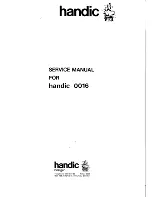
Radar Training System, LabVolt Series
7
© Festo Didactic
Parameter
Value
Maximum Range (Equiv. RCS of Target: 1 m²)
Typically more than 8 m (26 ft)
Range
1.8 m (5.9 ft), 3.6 m (11.8 ft), 7.2 m (23.6 ft), switch selectable
Range Resolution
Typically 15 cm (6 in)
Physical Characteristics
Dimensions
About 8 m² (86 ft²)
Net Weight
TBE
Radar Processor/Display (Level 2 and 3, add-On to Level 1)
8112498 (8097-20)
The Radar Processor/Display is used in conjunction with the
Basic Radar Training System, Model 8097-1, to form a complete
and modern pulse radar system. The Radar Processor/Display
adds the following elements to the Basic Radar Training System:
radar echo signal processing functions, PPI display functions,
on-screen block diagrams of the complete radar and radar
processor/display subsystem, and computer-based (i.e., on-
screen) instruments (oscilloscope and data monitoring system).
Two major types of radar echo signal processing function are
available: Moving Target Indication (MTI) and Moving Target
Detection (MTD). The Radar Processor/Display also provides computer-controlled generation of clutter and
interference to allow study of the MTI processing function. The following types of clutter and interference can be
generated: sea clutter, rain clutter, second-trace echo, noise, and pulse interference.
The Radar Processor/Display consists of a reconfigurable training module (RTM), a power supply for the RTM,
three interface modules, a set of accessories including the Radar Training System Software, two comprehensive
student manuals, and a user guide. A Windows
®
based host computer (to be purchased separately) is required
with the RTM. The Model 9695 Radar Host Computer is recommended.
Example of a PPI display obtained with the Radar Processor/Display.
The RTM is the cornerstone of the
Radar Processor/Display. This module,
which uses state-of-the-art digital
signal processor (DSP) technology, can
be programmed to act as either an
analog pulse radar (i.e., a pulse radar
with MTI processing) or a digital pulse
radar (i.e., a pulse radar using MTD,
correlation and interpolation, and
surveillance processing). Interface
modules that students install in the
RTM allow connection of the various
signals coming from the Basic Radar
Training System, as shown in Figure 1.
The RTM can also be programmed to
act as a tracking radar when used with
the Radar Tracking Training System,
Model 8096-3.








































